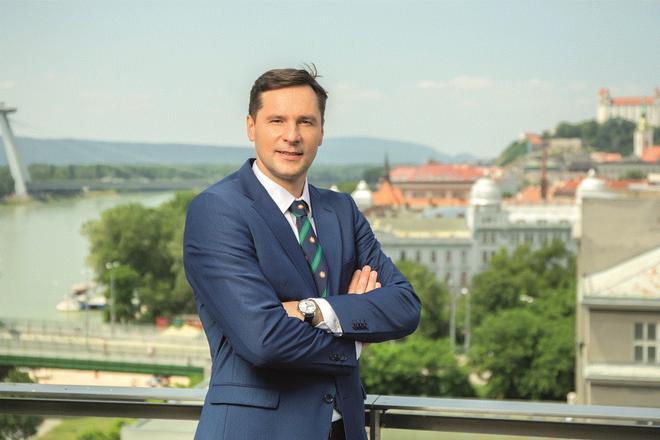The ELA, the first decentralized EU agency in Slovakia, will be seated in the commercial office space of J&T Real Estate, which was part of Slovakia’s successful offer in the tender between European Union member states. Attorney MARTIN PAVLE of the law firm Martin Pavle s. r. o. represented Slovakia throughout the process. He shared the details of the legal aspects of the transaction, which is unique in many ways.
The talks about the ELA moving to Slovakia started under the previous government. When did you join the process?
My role as an attorney was to represent the Slovak Republic and MH Invest s.r.o., a company that acted on behalf of the government, in close cooperation with the Ministry of Labour, Social Affairs and Family of the Slovak Republic. I led the negotiations about the lease and sublease between the lessor, a company of the J&T Real Estate group, MH Invest as lessee and the ELA as the sublessee. My task was to negotiate and finalise the legal aspects of the issue since I joined the process in the summer of 2019.
The negotiations were complicated and demanding as majority of the talks had to be mirrored: if we reached some conclusion with the lessor, we needed to go and talk about it with the sublesee, and vice versa. Although all parties were very flexible, closing the contract took much more work than in transaction including only domestic or only commercial subjects.
What was the complicated part?
The ELA and its staff have a specific status comparable with the staff of foreign diplomatic missions, based on Protocol No 7, that grants them privileges and immunities. The status of the agency, the privileges and immunities as well as the incentives of the Slovak Republic for basing the ELA in Bratislava needed to be anchored on the international level in the formal seat agreement and also reflected in lease and sublease agreements. Moreover, there are several procedures tied to contracting, such as approval from the budgetary authority on part of ELA and governmental approvals on Slovak part.
The ELA looked for large office spaces, which Slovakia does not own, so the commercial spaces on Landererova Street were offered by J&T Real Estate. Is it common for a European agency to be seated in commercial offices?
We conducted an analysis within the EU, which has shown that approximately half of the decentralized agencies are seated in commercial spaces, while the other half uses state-owned buildings.
What were the ELA’s main criteria when choosing the offices?
The total area and standard, the move-in date, incentives, logistical accessibility, and quality of life for the future ELA employees. Bratislava prevailed over its tender competitors when it comes to quality of life, and that is good news for Slovakia. The original requirement for the seat was 7,000 square metres, which was cut down to roughly 5,500 during the talks. The talks took a long time because the process of defining ELA’s requirements was rather vague and only became clearer over time after receipt of greenlight from stakeholders. In the resulting contracts, majority of contract obligations are mirrored, meaning the contract between Slovakia and J&T Real Estate contains similar conditions as the contract between Slovakia and the ELA.
For Slovakia, it is the first decentralised agency. What were your sources during the talks and setting up the rental contract?
Commercial spaces are used for these agencies for example in Finland, France, the Netherlands, or Hungary. We took some inspiration from there but needed to observe the Slovak law on non-residential premises and the Civil Code. We also used the basics of the contract normally used by J&T Real Estate. I believe we have managed to come up with decent and balanced contracts, beneficial for the leassor, the lessee and the sublesee.
The new seat of the European Medicines Agency (EMA) in the Netherlands is a commercial lease, too, though it is a slightly different case: it followed the model of a temporary lease in an existing building and subsequent move-in into a newly-built building based on the EMA’s criteria. This method would not be realistic in the ELA’s case because Slovakia’s offer to move to Bratislava was in line with the criteria of the tender in the fourth quarter of 2019.
What made this transaction different from a regular commercial lease?
Setting up the headquarters involved several agreements. The headquarters agreement between the host country, the Slovak Republic, and the ELA is an international agreement that covers the seat, subjectivity, privileges and immunities as well as further assistance from the Slovak Republic. The executive contracts regarding the seat are the agreement on the lease of non-residential premises, which the Slovak Republic, represented by MH Invest as the lessee, concluded with the lessor – a company of the J&T Real Estate group – and the agreement on sublease of non-residential premises between the lessee and the ELA as a sublesee.
Who is Martin Pavle?
JUDr. Martin Pavle (41) is the managing partner of the law firm Martin Pavle s.r.o. He graduated from the Comenius University, Faculty of Law in Bratislava in 2003. After completing his studies and a stay at the King’s College in London, he worked for major international and local law firms with a focus on M&A, real estate and public procurement. He has led the Martin Pavle s.r.o. law firm since 2007, which specialises in commercial law, real estate, IT and public procurement. He provides legal services to a range of clients from the private and public sectors.
This article has been created with the help of the law firm Martin Pavle s. r. o.

 Attorney Martin Pavle of the law firm Martin Pavle s. r. o.
Attorney Martin Pavle of the law firm Martin Pavle s. r. o.